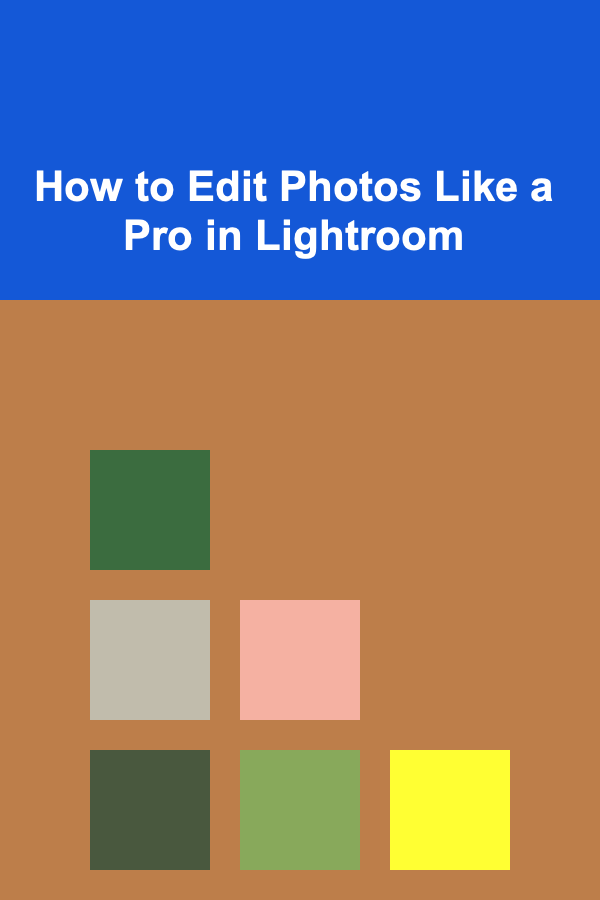
How to Edit Photos Like a Pro in Lightroom
ebook include PDF & Audio bundle (Micro Guide)
$12.99$5.99
Limited Time Offer! Order within the next:

Adobe Lightroom is a powerful photo editing software widely used by professional photographers, hobbyists, and enthusiasts alike. Whether you're looking to enhance the colors, fix lighting, or give your photos a creative touch, Lightroom offers a variety of tools and features that can elevate your images to a professional level. In this guide, we'll walk you through the essential techniques to edit photos like a pro in Lightroom, from basic adjustments to advanced editing tips.
Understanding Lightroom's Interface and Tools
Before diving into editing, it's essential to familiarize yourself with Lightroom's interface. Lightroom offers two main modules for photo editing: the Library Module and the Develop Module.
Library Module
The Library Module is where you import, organize, and manage your photos. It provides tools for sorting, rating, and flagging images, as well as batch processing. You can also perform basic adjustments such as cropping and rotating here.
Develop Module
The Develop Module is where the magic happens. This is the place to apply most of your editing adjustments. It provides a variety of tools for adjusting exposure, contrast, colors, sharpness, noise reduction, and more.
Lightroom also features a Histogram , which displays the tonal range of your image, and a Toolbar with essential editing tools such as cropping, spot removal, and graduated filters.
Key Panels in the Develop Module
- Basic Panel: This is where you'll make your primary adjustments, such as exposure, contrast, and white balance.
- Tone Curve: Adjust the brightness and contrast of specific tonal ranges.
- HSL/Color Panel: Control the hue, saturation, and luminance of individual colors.
- Detail Panel: Fine-tune sharpness and noise reduction.
- Lens Corrections: Fix lens distortions and chromatic aberration.
- Effects: Add grain, vignettes, and post-crop effects.
- Calibration Panel: Adjust color profiles and camera settings.
Basic Adjustments: Exposure, Contrast, and White Balance
Exposure and Contrast
One of the first things you'll want to adjust when editing photos in Lightroom is the exposure . Exposure determines the overall brightness of the image. Too much exposure results in overexposed highlights, while too little can make the photo too dark. To adjust exposure, use the Exposure Slider in the Basic Panel.
Alongside exposure, adjusting the contrast is crucial for making your image pop. Increasing the contrast will make light areas brighter and dark areas darker, giving the image more depth. Decreasing the contrast can help create a more muted, softer look.
White Balance
White balance controls the color temperature of your image. If your photo has a blue or orange tint, it's usually due to incorrect white balance. Lightroom allows you to adjust white balance using the Temp and Tint sliders in the Basic Panel . You can also use the White Balance Selector tool (the eyedropper icon) to click on an area of the photo that should be white or neutral, and Lightroom will automatically adjust the white balance.
Enhancing Details: Clarity, Texture, and Dehaze
Clarity
The Clarity slider in Lightroom adjusts the midtone contrast of an image. Increasing clarity can make textures and details more prominent, giving the photo a more defined and sharper look. However, be cautious not to overdo it, as excessive clarity can introduce unwanted artifacts.
Texture
The Texture slider is a more subtle alternative to clarity, focusing on small details in the image. It's especially useful for fine-tuning skin tones, foliage, and other detailed areas. Increasing the texture will enhance finer details, while reducing it can soften the image.
Dehaze
The Dehaze slider is a fantastic tool for reducing or adding haze to an image, especially in photos with foggy or overcast conditions. Increasing the dehaze will make the image appear clearer, while reducing it can introduce a dreamy, atmospheric effect.
Adjusting Colors: HSL/Color Panel
Hue, Saturation, and Luminance
The HSL/Color Panel (Hue, Saturation, Luminance) is an incredibly powerful tool for fine-tuning the color aspects of your image. This panel allows you to adjust the hue (the color itself), saturation (the intensity of the color), and luminance (the brightness of the color) for individual color ranges.
- Hue: Use the Hue sliders to shift colors in the image. For example, you can turn a green sky to a blue hue or change the red tones in a sunset to orange.
- Saturation: This controls the intensity of the color. Boosting saturation makes colors more vivid, while reducing it creates a more muted look.
- Luminance: Adjust the brightness of individual colors. For example, you can brighten the blues in a sky without affecting the rest of the image.
The HSL/Color panel allows for granular control of your image's colors, and you can selectively adjust specific colors in your photo to make them pop or tone them down.
Split Toning
Split toning is a technique that applies different colors to the highlights and shadows of an image. In Lightroom, the Split Toning panel allows you to add specific hues to the highlight and shadow areas of the photo. This can create artistic effects, such as a warm golden highlight with a cool blue shadow, giving your photo a more cinematic feel.
Sharpening and Noise Reduction
Sharpening
Sharpness is a key factor in making a photo appear more professional. Lightroom provides a range of tools for sharpening your image. Use the Detail Panel to adjust the Amount , Radius , and Detail sliders to sharpen your image. Start with a lower Amount and increase gradually to avoid introducing unwanted noise or halos around edges.
Noise Reduction
When you increase the ISO of your camera, noise can become more noticeable, especially in low-light photos. Lightroom's Noise Reduction slider helps reduce the grainy appearance that often comes with higher ISO settings. Be careful not to overdo the noise reduction, as it can result in a loss of fine detail.
Advanced Techniques: Gradients, Brushes, and Spot Removal
Graduated Filter
The Graduated Filter is an essential tool for making local adjustments to your image, particularly when you want to adjust areas of the photo gradually. For example, you can use the graduated filter to enhance the sky in a landscape photo or apply a subtle vignette effect around the edges.
To apply a graduated filter, click on the Graduated Filter Tool (the triangle icon) and drag it across the area of the photo you want to adjust. You can then fine-tune the exposure, contrast, and other settings for that area.
Adjustment Brush
The Adjustment Brush allows you to apply localized edits to specific areas of the image. This is especially useful for areas where you want to make detailed adjustments, such as brightening a subject's face, increasing the saturation of flowers, or correcting exposure in a specific area.
To use the brush, click on the Adjustment Brush icon, choose your settings, and then paint over the area you want to adjust. You can modify settings like exposure, contrast, clarity, and saturation specifically for that area.
Spot Removal
The Spot Removal Tool is perfect for removing distractions from your photos, such as dust spots, blemishes, or unwanted objects. The tool uses a healing or cloning method to replace the unwanted area with pixels from nearby parts of the image. Simply click on the area you want to remove, and Lightroom will automatically attempt to find a suitable match.
Finishing Touches: Vignetting and Effects
Vignetting
A vignette is a subtle darkening or lightening around the edges of the photo. It can help focus attention on the subject and create a more professional, polished look. To apply a vignette in Lightroom, go to the Effects Panel and adjust the Post-Crop Vignetting sliders. You can increase the amount of vignetting or adjust its roundness, feather, and midpoint.
Grain
Adding a bit of grain can give your photo a more cinematic or vintage feel. Lightroom allows you to adjust the amount, size, and roughness of the grain using the Grain slider in the Effects Panel.
Final Export: Choosing the Right Settings
Once you've finished editing your photo in Lightroom, it's time to export it. The export settings will depend on what you plan to do with the photo, whether it's for printing, web use, or sharing on social media.
Export Settings for Web and Social Media
For web and social media use, you'll want to keep the file size small while maintaining good image quality. Choose JPEG format and adjust the quality slider to about 80-90%. Set the resolution to 72 pixels per inch (PPI) for web use, and make sure to resize the image to the appropriate dimensions for the platform you're using.
Export Settings for Printing
If you're exporting for print, choose TIFF or JPEG format with a higher quality setting (about 100%) and a resolution of 300 PPI. This ensures that your image retains the necessary detail for printing.
Conclusion
Editing photos like a pro in Lightroom is all about understanding the tools available and knowing how to apply them creatively to enhance your images. Whether you're making basic adjustments to exposure or diving into advanced techniques like split toning and local adjustments, Lightroom provides the flexibility and power needed to transform your photos into professional-quality images.
With practice and experimentation, you'll soon develop your own editing style and workflow, allowing you to create stunning photos that stand out. So, fire up Lightroom, start editing, and enjoy the process of bringing your vision to life!

How to Clean and Freshen Up Your Bedding
Read More
How to Create a Checklist for Securing Event Speakers and Performers
Read More
How to Incorporate Lighting into Your Home Renovation
Read More
How to Organize Your Wardrobe with the Right Storage Solutions
Read More
How to Save Money on Cleaning Supplies and Household Products
Read More
How To Understand Cooperative Storytelling Games
Read MoreOther Products

How to Clean and Freshen Up Your Bedding
Read More
How to Create a Checklist for Securing Event Speakers and Performers
Read More
How to Incorporate Lighting into Your Home Renovation
Read More
How to Organize Your Wardrobe with the Right Storage Solutions
Read More
How to Save Money on Cleaning Supplies and Household Products
Read More